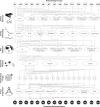The influence of decision-making in tree ring-based climate reconstructions
- PMID: 34099683
- PMCID: PMC8184857
- DOI: 10.1038/s41467-021-23627-6
The influence of decision-making in tree ring-based climate reconstructions
Abstract
Tree-ring chronologies underpin the majority of annually-resolved reconstructions of Common Era climate. However, they are derived using different datasets and techniques, the ramifications of which have hitherto been little explored. Here, we report the results of a double-blind experiment that yielded 15 Northern Hemisphere summer temperature reconstructions from a common network of regional tree-ring width datasets. Taken together as an ensemble, the Common Era reconstruction mean correlates with instrumental temperatures from 1794-2016 CE at 0.79 (p < 0.001), reveals summer cooling in the years following large volcanic eruptions, and exhibits strong warming since the 1980s. Differing in their mean, variance, amplitude, sensitivity, and persistence, the ensemble members demonstrate the influence of subjectivity in the reconstruction process. We therefore recommend the routine use of ensemble reconstruction approaches to provide a more consensual picture of past climate variability.
Conflict of interest statement
The authors declare no competing interests.
Figures





References
-
- Esper J, et al. Ranking of tree-ring based temperature reconstructions of the past millennium. Quat. Sci. Rev. 2016;145:134–151. doi: 10.1016/j.quascirev.2016.05.009. - DOI
-
- Büntgen U, et al. Prominent role of volcanism in Common Era climate variability and human history. Dendrochronologia. 2020;64:125757. doi: 10.1016/j.dendro.2020.125757. - DOI
-
- Ljungqvist FC, et al. Ranking of tree-ring based hydroclimate reconstructions of the past millennium. Quat. Sci. Rev. 2020;230:106074. doi: 10.1016/j.quascirev.2019.106074. - DOI
-
- St. George S. An overview of tree-ring width records across the Northern Hemisphere. Quat. Sci. Rev. 2014;95:132–150. doi: 10.1016/j.quascirev.2014.04.029. - DOI
Publication types
LinkOut - more resources
Full Text Sources
Miscellaneous

